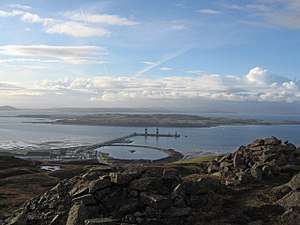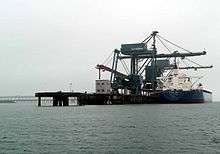Hunterston Terminal
Hunterston Terminal, in North Ayrshire, Scotland, was a coal-handling port located at Fairlie on the Firth of Clyde, and operated by The Peel Group. It lies south of Fairlie, adjacent to Hunterston estate, site of Hunterston Castle, and its jetty projects out approximately 1 mile (1.6 km), about midway into the channel between the mainland and the island of Great Cumbrae.
| Hunterston Terminal | |
|---|---|
 View from Kaim Hill over the terminal, loop railway line and jetty, towards Great Cumbrae | |
| Location | |
| Country | United Kingdom |
| Location | Fairlie, North Ayrshire, Scotland |
| Coordinates | 55°44′17″N 4°51′59″W |
| Details | |
| Opened | 1979 |
| Operated by | The Peel Group |
The port, completed in 1979, was originally called Hunterston Ore Terminal and was intended to handle iron ore for British Steel Corporation's Ravenscraig steelworks. Existing facilities at General Terminus Quay on the upper River Clyde were unsuitable for increasingly large vessels, but Hunterston, with its one-mile-long (1.6 km) jetty, is able to handle modern ships of any size.
History
The new port at Hunterston replaced facilities at General Terminus Quay (now Springfield Quay), on the River Clyde, near the centre of Glasgow.[1] These facilities had been designed in the early 1950s to allow the simultaneous unloading of two large ships carrying bulk iron ore.[1] The ships were designed to carry 12,000 tons (12,200 metric tonnes) of iron ore.[2] Iron ore was to be transported, in railway waggons, via the General Terminus and Glasgow Harbour Railway, from the General Terminus Quay to the new Ravenscraig steelworks which opened in the late 1950s.
Facilities at Hunterston Terminal

At Hunterston Terminal, an overhead conveyor linked to two gantry cranes carries coal to a railhead on the Ayrshire Coast Line railway. Clydeport claim an unloading rate of 2800 tonnes of coal per hour. The conveyor is also linked to a ship loader which loads coal into smaller ships on the inner berth; this coal is transported to Manchester and Belfast amongst other places.
Among other users, coal from Hunterston Terminal supplied Drax power station in Yorkshire and was used at Longannet power station in Fife until its closure in 2016. The need to link to Longannet was a major reason for the reopening of the Stirling-Alloa-Kincardine rail link, although this only served the plant for its last eight years.
The site is currently under demolition with both unloaders expected to be removed imminently.
References
- Notes
- Campbell, R.H. Iron and Steel. Chapter 5 in: Cunnison and Gilfillan (1958).
- Sleeman (1958). The Present System: The Port of Glasgow To-day. In Chapter 10 of: Cunnison & Gilfillan (1958).
- Sources
- Cunnison, J. and Gilfillan, J.B.S., (1958). The City of Glasgow (The Third Statistical Account of Scotland, Volume V). Glasgow: William Collins Sons & Co. Ltd.